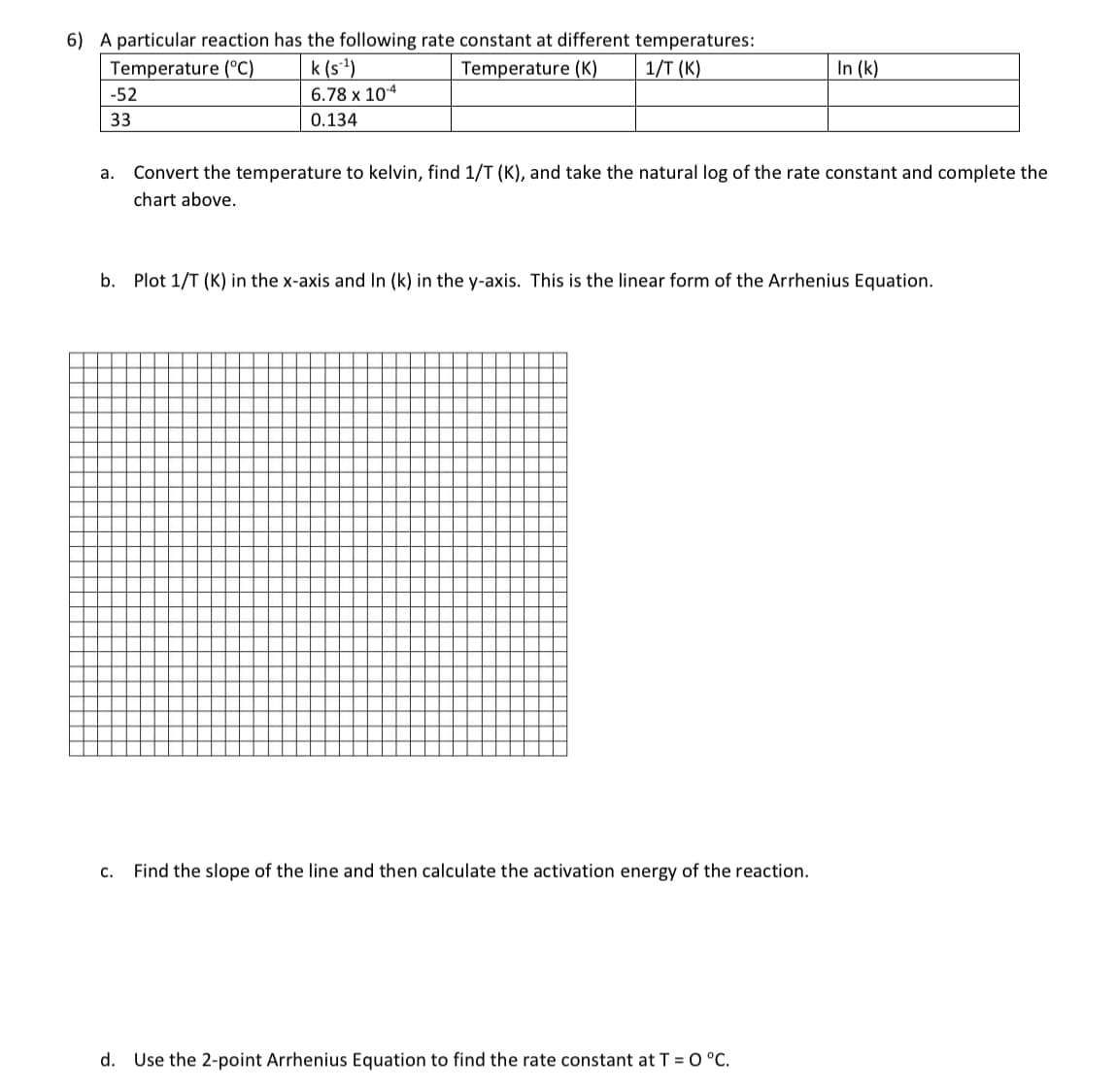6) A particular reaction has the following rate constant at different temperatures: Temperature (°C) k (s¹) Temperature (K) 1/T (K) 6.78 x 10-4 0.134 -52 33 In (k) a. Convert the temperature to kelvin, find 1/T (K), and take the natural log of the rate constant and complete the chart above. b. Plot 1/T (K) in the x-axis and In (k) in the y-axis. This is the linear form of the Arrhenius Equation.
6) A particular reaction has the following rate constant at different temperatures: Temperature (°C) k (s¹) Temperature (K) 1/T (K) 6.78 x 10-4 0.134 -52 33 In (k) a. Convert the temperature to kelvin, find 1/T (K), and take the natural log of the rate constant and complete the chart above. b. Plot 1/T (K) in the x-axis and In (k) in the y-axis. This is the linear form of the Arrhenius Equation.
Chemistry & Chemical Reactivity
9th Edition
ISBN:9781133949640
Author:John C. Kotz, Paul M. Treichel, John Townsend, David Treichel
Publisher:John C. Kotz, Paul M. Treichel, John Townsend, David Treichel
Chapter14: Chemical Kinetics: The Rates Of Chemical Reactions
Section: Chapter Questions
Problem 12PS: The reaction 2 NO(g) + 2 H2(g) N2(g) + 2 H2O(g) was studied at 904 C, and the data in the table...
Related questions
Question

Transcribed Image Text:6) A particular reaction has the following rate constant at different temperatures:
Temperature (°C)
k (s¹)
Temperature (K)
1/T (K)
6.78 x 10-4
0.134
-52
33
a. Convert the temperature to kelvin, find 1/T (K), and take the natural log of the rate constant and complete the
chart above.
In (k)
b. Plot 1/T (K) in the x-axis and In (k) in the y-axis. This is the linear form of the Arrhenius Equation.
C. Find the slope of the line and then calculate the activation energy of the reaction.
d. Use the 2-point Arrhenius Equation to find the rate constant at T = 0 °C.
Expert Solution
Step 1
We now the Arrhenius equation for activation energy determination.
ln(k2/k1) = Ea/R x (1/T1 - 1/T2)
where,
Ea = the activation energy of the reaction in J/mol
R = the ideal gas constant = 8.3145 J/K·mol
T1 and T2 = absolute temperatures (in Kelvin)
k1 and k2 = the reaction rate constants at T1 and T2
So it is very important equation for activation energy determination
Step by step
Solved in 2 steps with 2 images

Knowledge Booster
Learn more about
Need a deep-dive on the concept behind this application? Look no further. Learn more about this topic, chemistry and related others by exploring similar questions and additional content below.Recommended textbooks for you

Chemistry & Chemical Reactivity
Chemistry
ISBN:
9781133949640
Author:
John C. Kotz, Paul M. Treichel, John Townsend, David Treichel
Publisher:
Cengage Learning

Chemistry & Chemical Reactivity
Chemistry
ISBN:
9781337399074
Author:
John C. Kotz, Paul M. Treichel, John Townsend, David Treichel
Publisher:
Cengage Learning

Chemistry by OpenStax (2015-05-04)
Chemistry
ISBN:
9781938168390
Author:
Klaus Theopold, Richard H Langley, Paul Flowers, William R. Robinson, Mark Blaser
Publisher:
OpenStax

Chemistry & Chemical Reactivity
Chemistry
ISBN:
9781133949640
Author:
John C. Kotz, Paul M. Treichel, John Townsend, David Treichel
Publisher:
Cengage Learning

Chemistry & Chemical Reactivity
Chemistry
ISBN:
9781337399074
Author:
John C. Kotz, Paul M. Treichel, John Townsend, David Treichel
Publisher:
Cengage Learning

Chemistry by OpenStax (2015-05-04)
Chemistry
ISBN:
9781938168390
Author:
Klaus Theopold, Richard H Langley, Paul Flowers, William R. Robinson, Mark Blaser
Publisher:
OpenStax

Chemistry: Principles and Reactions
Chemistry
ISBN:
9781305079373
Author:
William L. Masterton, Cecile N. Hurley
Publisher:
Cengage Learning

Chemistry for Engineering Students
Chemistry
ISBN:
9781337398909
Author:
Lawrence S. Brown, Tom Holme
Publisher:
Cengage Learning

Chemistry
Chemistry
ISBN:
9781305957404
Author:
Steven S. Zumdahl, Susan A. Zumdahl, Donald J. DeCoste
Publisher:
Cengage Learning